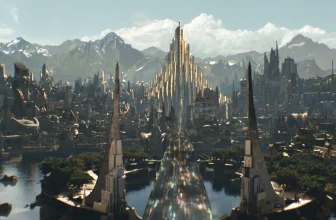The City as a Cinematic Stage
When watching a movie, we may not understand at first glance how important the background really is. We focus on the dialogues, the plot; and we merely are aware of the existence of the backdrop. But imagine a memorable scene without the given setting, being instead set in an impersonal or random environment or shot against a painted backdrop: it gets pretty complicated. Let’s be honest, whoever has ever found himself in the city where his favourite movie was set has made a pilgrimage to the places where it has been shot. Architecture plays an important role in cinema, sometimes making the movie evermore unforgettable.
Talking about cinema and the city, what a city needs in order to be ‘ideal’ is to be a stage and at the same time to offer scenic elements; architecture can be used and manipulated by directors who create a brand new city-stage. We will shortly try to investigate, using three cases, not only how much significance a given urban background has in a movie but also how frequently directors play with the architecture of a city going beyond any awes and sometimes making a vailed parody of its excesses.
The temptations of Doctor Antonio is the episode directed by Federico Fellini from the movie Boccaccio ’70 (1962).
There is a scene in the episode that confuses the audience throughout-what one sees projected on the screen is the metaphysical architecture of the EUR district in Rome; the actress Anita Ekberg is walking and dancing smiling through the monumental architecture. Herein lies the issue: Anita is just as tall as the arches of a building. The building in question is the Palace of Italian Civilization, also known as Square Coliseum, originally 53 meters tall, which in the spectacular scene no longer appears to be genuine.
In the movie the buildings of the district have both become scenic elements out of proportion, assembled in the location of Cinecittà, and a stage where to perform a play. A fascinating aspect in question is that the usage of this district as a stage allows us to learn something about its history. The construction of EUR, indeed, was started in 1938 and had to be completed by 1942, and it was supposed to be the theatre -the stage – of a real event: the World’s Fair. Because of the Second World War the project was left unfinished; the lack of spectacularization drove Fellini to fill it with proper masquerades. The theatre was originally planned as a stage for the display of power, later this stage was re-used for collective performances. The square became the stage and the soundstage upon which elements were assembled, and the incomplete nature of the EUR allows the reproduction of its buildings in different scales and locations. As a laboratory specialized in the reproduction of scenic elements, the EUR, finally offers a selection of neoclassical and monumental buildings recalling the magnificent architectures of the Roman Empire. Thus the movie strengthened the metaphysical aspect of the architecture of the district, whose appearance goes beyond the experienced reality and makes it unique.
Playtime, a movie by Jacques Tati (1967).
Jacques Tati made an elegant parody of modern architecture in creating his Tativille. The movie showcases emphasized features of modern construction, the observer can recognize in the architecture of Tativille models, the modern architecture set in a futuristic Paris. As a matter of fact, the protagonists of the movie are Monsieur Hulot and a group of tourists, whose expectation is to see ancient Paris whereas reality shows them an extremely modern side of the city.
Tativille celebrates the defects of modern architecture and of the International Style. Modern Architecture gave resonance to functionality and simplicity, and unveiled structural elements without covering them with any envelope; it also mostly preferred materials such as steel and glass. The use of ribbon windows and the concept of openness, for instance, is stressed in the scenic design of the movie. During the night from the street, where cars are moving fast, it is clearly possible to see what is happening inside a transparent building, designed as a multi storeyed stage. When Monsieur Hulot, during one of his itinerary around the city, decides to visit the main building of a corporation, he observes an exaggerated example of modern architecture. The workstations of the corporation, in fact, are nothing other than small and identical prefabricated containers; even the furniture is identical. The fascinating aspect is that in the consecutive scene, what appear on the screen is a fair where all these products of mass production are exhibited and the stalls are extremely similar to the workstations. Could it maybe be a critique of modern architecture and its inclination to reduce dwellings into standardized models?
The modern atmosphere is also given by reduced dialogues, substituted by modern noise.
The inhabitants of Tativille perform the everyday scenery of the city where everything is a kaleidoscope of simulations set in the in-between modern spaces.
Manhattan, a movie by Woody Allen (1979).
The skyline of the town became the backdrop of the play. The audience sitting in a dark movie theatre experienced a guided tour through the black and white city; an architectural promenade. The romanticized images of a chaotic city which remains impressed in the mind of the flâneur.When watching the movie we all become contemporary flâneur just like the main character, enraptured by the view of the majestic architecture. The expectations are high, and are raised by the poster of the movie itself and the lettering chosen; the word ‘manhattan’ is a hybrid of letters and skyscrapers’ outlines. A magical city made of lights, signs, traffic jam, the Fifth Avenue, Park Avenue and the impressive building of the Guggenheim Museum by Wright. The movie traces an itinerary to help us admire the city; New York is depicted as a people-oriented city.
Allen really celebrates the city as he finally states in the memorable scene shot by the Queensboro Bridge, ‘boy, this is a really great city. I don’t care what anybody says’.
By: Alessandra Zucchetta








